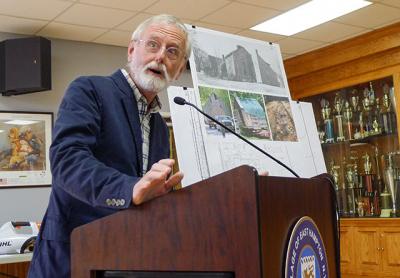Dominy Shops Will Move Back to North Main

Preparations are well underway to return the historical Dominy clock and woodworking shops, which date to the late 18th century, to their original location on North Main Street in East Hampton Village, where they are to be connected by a reconstruction of the timber frame Dominy house that also had been on the site and begin a new life as a museum and educational center.
At the East Hampton Village Board’s work session last Thursday, Robert Hefner, the village director of historic services, and Richard Barons, the former executive director of the East Hampton Historical Society, briefed members on the project. Rebecca Hansen, the village administrator, said on Monday that it is hoped that the shops will be moved next summer or fall.
The 1791 woodworking shop and 1798 clock shop stood on North Main Street until 1946. Several generations of the family, including Nathaniel Dominy IV, his son Nathaniel V, and his grandson Felix, were renowned for their woodworking and clock and watch-making skills. Their work is honored at the Winterthur Museum in Delaware, with a replica of one of the shops having been constructed and original tools and equipment on display.
In 1946, the shops were in disrepair and about to be demolished when Dudley Roberts, a part-time East Hampton resident who was the founder and president of Cinerama Productions and the investment banking firm Roberts and Company, rescued them, moving them to his property at 62 Further Lane, and combining them into a single residential structure. The Dominy house was dismantled.
In 2014, Barry Rosenstein, a hedge fund manager and founder of the multibillion-dollar Jana Partners, purchased the former Roberts property along with 60 and 64 Further Lane for a reported $147 million. He subsequently donated the combined structure to the village, and it was moved in the summer of 2016 to the Mulford Farm for safekeeping.
“The concept is to put the two shops back to their exact, original locations,” on the grass border between North Main Street and the municipal parking lot, Mr. Hefner said. “The idea is to join them with a reconstruction of the timber frame and exterior of the Dominy house. That not only gives them their original context as being part of a house, rather than being two separate little buildings, but also it allows us to have, in the interior of the Dominy house part of it, an exhibit and educational center.”
Mr. Hefner told the board that it was fortunate that six years before the clock and woodworking shops were moved, the Historic American Buildings Survey, the nation’s first federal preservation program, did an extensive study of the Dominy house. More than 100 pages of sketches, dimensions, and field notes from the survey will allow an accurate reconstruction of the house, he said. “It was really quite a fancy house,” he said, adding that it had “expressed their skill, their aesthetic sense, and their standing in the community.”
Scott Fithian, the village superintendent of public works, and members of his department “did an archaeology expedition to that site,” Mr. Hefner said, exposing a foundation wall of the house and clock shop, which will allow the structures’ precise placement. Two Norway maple trees and one eastern white pine will be removed to accommodate the structures and a chain-link fence will be removed and replaced with a picket fence.
Mr. Barons called the cottages’ present condition astonishing and extraordinary. “When they were transformed over the years into guest cottages, they were not altered,” he said. “The walls still have the nails on them where tools were held,” and remnants illustrating where shelves and ladders were situated also remain. “Most of the original color on the plank walls is still there,” he said.
“But what makes this so important,” Mr. Barons said, “is it talks about the people who built the community.” This may be the nation’s last existing 18th-century furniture shop, he said, offering outstanding educational possibilities.
On Saturday, Charles F. Hummel, the pre-eminent expert on the Dominy woodworkers and curator emeritus at Winterthur, will be in East Hampton to give the keynote address at a fund-raising lunch for the Ladies Village Improvement Society. The event — titled “Unique: The Dominy Craftsmen and a Second Chance” — is sponsored by the L.V.I.S.’s landmarks committee and will be held at the Maidstone Club on Old Beach Lane, starting at 11:30 a.m.
Mr. Hummel will speak about the Dominy clock shop and the re-creation of the workshop that can be seen at Winterthur, as well as the mysteries that antiques sleuths such as himself must unravel when attempting to authenticate furniture and tools. Charles Keller and Glenn Purcell, the foremost local experts on the Dominys, who organized an exhibition of new Dominy discoveries at Clinton Academy for the East Hampton Historical Society in 2010, will also be in attendance. More information on the lunch is available at (631) 324-1220.
The Dominy Shops were designated a historical landmark by the village board in 2013. Therefore, the village had to obtain a certificate of appropriateness from the design review board so that work could be done; that was obtained on Tuesday. With that in hand, Mr. Hefner said he and Drew Bennett, a consulting engineer, would prepare specifications so that the board can issue a request for proposals from contractors.
“It’s all coming together,” Mr. Barons said. “It should be a glory for North Main Street.”
